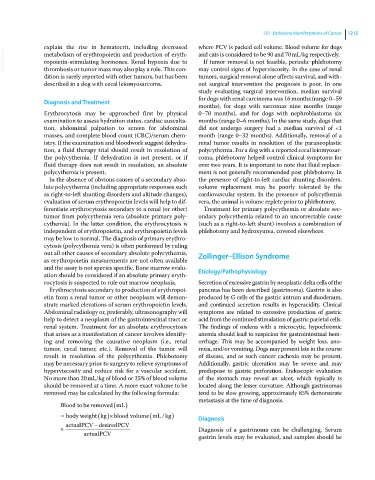Page 1277 - Clinical Small Animal Internal Medicine
P. 1277
131 Endocrine Manifestations of Cancer 1215
explain the rise in hematocrit, including decreased where PCV is packed cell volume. Blood volume for dogs
VetBooks.ir metabolism of erythropoietin and production of eryth- and cats is considered to be 90 and 70 mL/kg respectively.
If tumor removal is not feasible, periodic phlebotomy
ropoietin‐stimulating hormones. Renal hypoxia due to
thrombosis or tumor mass may also play a role. This con-
dition is rarely reported with other tumors, but has been may control signs of hyperviscosity. In the case of renal
tumors, surgical removal alone affects survival, and with-
described in a dog with cecal leiomyosarcoma. out surgical intervention the prognosis is poor. In one
study evaluating surgical intervention, median survival
for dogs with renal carcinoma was 16 months (range 0–59
Diagnosis and Treatment
months), for dogs with sarcomas nine months (range
Erythrocytosis may be approached first by physical 0–70 months), and for dogs with nephroblastoma six
examination to assess hydration status, cardiac ausculta- months (range 0–6 months). In the same study, dogs that
tion, abdominal palpation to screen for abdominal did not undergo surgery had a median survival of <1
masses, and complete blood count (CBC)/serum chem- month (range 0–32 months). Additionally, removal of a
istry. If the examination and bloodwork suggest dehydra- renal tumor results in resolution of the paraneoplastic
tion, a fluid therapy trial should result in resolution of polycythemia. For a dog with a reported cecal leiomyosar-
the polycythemia. If dehydration is not present, or if coma, phlebotomy helped control clinical symptoms for
fluid therapy does not result in resolution, an absolute over two years. It is important to note that fluid replace-
polycythemia is present. ment is not generally recommended post phlebotomy. In
In the absence of obvious causes of a secondary abso- the presence of right‐to‐left cardiac shunting disorders,
lute polycythemia (including appropriate responses such volume replacement may be poorly tolerated by the
as right‐to‐left shunting disorders and altitude changes), cardiovascular system. In the presence of polycythemia
evaluation of serum erythropoietin levels will help to dif- vera, the animal is volume replete prior to phlebotomy.
ferentiate erythrocytosis secondary to a renal (or other) Treatment for primary polycythemia or absolute sec-
tumor from polycythemia vera (absolute primary poly- ondary polycythemia related to an uncorrectable cause
cythemia). In the latter condition, the erythrocytosis is (such as a right‐to‐left shunt) involves a combination of
independent of erythropoietin, and erythropoietin levels phlebotomy and hydroxyurea, covered elsewhere.
may be low to normal. The diagnosis of primary erythro-
cytosis (polycythemia vera) is often performed by ruling
out all other causes of secondary absolute polycythemia, Zollinger–Ellison Syndrome
as erythropoietin measurements are not often available
and the assay is not species specific. Bone marrow evalu- Etiology/Pathophysiology
ation should be considered if an absolute primary eryth-
rocytosis is suspected to rule out marrow neoplasia. Secretion of excessive gastrin by neoplastic delta cells of the
Erythrocytosis secondary to production of erythropoi- pancreas has been described (gastrinoma). Gastrin is also
etin from a renal tumor or other neoplasm will demon- produced by G cells of the gastric antrum and duodenum,
strate marked elevations of serum erythropoietin levels. and continued secretion results in hyperacidity. Clinical
Abdominal radiology or, preferably, ultrasonography will symptoms are related to excessive production of gastric
help to detect a neoplasm of the gastrointestinal tract or acid from the continued stimulation of gastric parietal cells.
renal system. Treatment for an absolute erythrocytosis The findings of melena with a microcytic, hypochromic
that arises as a manifestation of cancer involves identify- anemia should lead to suspicion for gastrointestinal hem-
ing and removing the causative neoplasm (i.e., renal orrhage. This may be accompanied by weight loss, ano-
tumor, cecal tumor, etc.). Removal of the tumor will rexia, and/or vomiting. Dogs may present late in the course
result in resolution of the polycythemia. Phlebotomy of disease, and as such cancer cachexia may be present.
may be necessary prior to surgery to relieve symptoms of Additionally, gastric ulceration may be severe and may
hyperviscosity and reduce risk for a vascular accident. predispose to gastric perforation. Endoscopic evaluation
No more than 20 mL/kg of blood or 25% of blood volume of the stomach may reveal an ulcer, which typically is
should be removed at a time. A more exact volume to be located along the lesser curvature. Although gastrinomas
removed may be calculated by the following formula: tend to be slow growing, approximately 85% demonstrate
metastasis at the time of diagnosis.
Blood toberemoved mL
body weightkg blood volumemLkg Diagnosis
/
actualPCVdesiredPCV Diagnosis of a gastrinoma can be challenging. Serum
acctualPCV gastrin levels may be evaluated, and samples should be

